Baring-Gould Sabine

The Reverend Sabine Baring-Gould (28 January 1834 – 2 January 1924) was an English hagiographer, antiquarian, novelist and eclectic scholar. His bibliography lists more than 1240 separate publications, though this list continues to grow. His family home, Lew Trenchard Manor near Okehampton, Devon, has been preserved as he rebuilt it and is now a hotel. He is remembered particularly as a writer of hymns, the best-known being "Onward, Christian Soldiers" and "Now the Day Is Over". He also translated the carol "Gabriel's Message" from Basque to English. He habitually wrote standing up, and his desk can be seen in the manor. Because the family spent much of his childhood travelling round Europe, his education was mostly conducted by private tutors. He spent a period of about two years in formal schooling, first at King's College School in London (then located in Somerset House) and then, for a few months, at Warwick Grammar School (now Warwick School). Here his time was cut short when a bronchial attack of the kind that was to plague him throughout his long life gave his father the excuse for another trip to the South of France for the sake of the boy's health. In 1853 he went up to Cambridge, earning the degrees of Bachelor of Arts in 1857, then Master of Arts in 1860 from Clare College, Cambridge.[1] In 1864, he became the curate at Horbury Bridge, West Riding of Yorkshire. It was while acting as a curate that he met and fell in love with Grace Taylor, the 16-year-old daughter of a mill hand. He sent Grace to live for two years with a vicar's family in York to learn proper manners, then brought her back and married her in 1868 at Wakefield.[2] [3] Their marriage lasted until her death 48 years later, and the couple had 15 children, all but one of whom lived to adulthood. When he buried his wife in 1916 he had carved on her tombstone the Latin motto Dimidium Animae Meae ("Half my Soul"). In 1871 Baring-Gould became the rector of East Mersea in Essex, where he spent 10 years. In 1880 he inherited the family estates of Lew Trenchard, Devon, which comprised 3,000 acres (12 km²), and the gift of the living of Lew Trenchard parish. He was already in holy orders, so when the living became vacant in 1881, he was able to appoint himself to it, becoming parson as well as squire. He did a great deal of work restoring St. Peter’s Church, Lew Trenchard, and (from 1883-1914) thoroughly remodelling his home Lew Trenchard Manor. Baring-Gould died on 2 January 1924 at his home at Lew Trenchard and was buried next to his wife, Grace. He regarded as his principal achievement the collection of folk songs that he made with the help of the ordinary people of Devon and Cornwall. His first book of songs, Songs and Ballads of the West (1889–91), was the first collection published for the mass market. The musical editor for this collection was Henry Fleetwood Sheppard, though some of the songs included were noted by Baring-Gould's other collaborator Frederick Bussell. Baring-Gould and Sheppard produced a second collection called A Garland of Country Songs in 1895. A new edition of Songs of the West was proposed for publication in 1905. Sheppard had died in 1901 and so the collector Cecil Sharp was invited to undertake the musical editorship for the new edition. Sharp and Baring-Gould also collaborated on English Folk Songs for Schools in 1907. This collection of 53 songs was widely used in British schools for the next 60 years. Though he had to modify the words of some songs which were too rude for Victorian ears, he left his original manuscripts for future students of folk song. His work preserved many beautiful pieces of music and their lyrics which otherwise might have been lost. The folk-song manuscripts from Baring-Gould's personal library and from public libraries have been published as a microfiche edition available for study in the main Devon Libraries and other places (including the Vaughan Williams memorial Library in London). Thirty boxes of unpublished manuscript material on other topics (the Killerton manuscripts) are kept in the Devon Record Office in Exeter. The folksong manuscripts, including the notebooks used in the field, given to Plymouth Public Library were deposited with the Plymouth and West Devon Record Office in 2006. Cecil Sharp dedicated his English Folk Song—Some Conclusions to Baring-Gould. Baring-Gould wrote many novels (including Mehalah), a collection of ghost stories, a 16-volume The Lives of the Saints, and the biography of the eccentric poet-vicar of Morwenstow, Robert Stephen Hawker. His folkloric studies resulted in The Book of Were-Wolves (1865), one of the most frequently cited studies of lycanthropy. One of his most enduringly popular works was Curious Myths of the Middle Ages , first published in two parts in 1866 and 1868, and republished in many other editions since then. "Each of the book's twenty-four chapters deals with a particular medieval superstition and its variants and antecedents," writes critic Steven J. Mariconda.[4] H. P. Lovecraft called it "that curious body of medieval lore which the late Mr. Baring-Gould so effectively assembled in book form."[5] He wrote much about the Westcountry: his works in this field include:- Baring-Gould served as President of the Royal Institution of Cornwall for ten years, starting in 1897.[6] Stories of his own eccentricity have been exaggerated. He did for a time, have a bat in his care while he was teaching at Hurstpierpoint. More usually it lived in an old sock in his room, where its life was ended when a housemaid stepped on it. It is also told how, at a children's party he asked a small girl, "And whose little girl are you?" whereon she burst into tears, and said: "I'm yours, Daddy." This story was verified by his daughter, Joan, who said that the little girl had been herself. One grandson, William Stuart Baring-Gould, was a noted Sherlock Holmes scholar who wrote a fictional biography of the great detective—in which, to make up for the lack of information about Holmes's early life, he based his account on the childhood of Sabine Baring-Gould. Sabine himself is a major character in Laurie R. King's Sherlock Holmes novel The Moor, a Sherlockian pastiche. In this novel it is revealed that Sabine Baring-Gould is the godfather of Sherlock Holmes. His wife Grace died in April 1916. They had 15 children: Mary, Margaret (an artist who painted part of the screen in Lew Trenchard Church), Edward Sabine, Beatrice Gracieuse (d. 1876, aged 3 years), Veronica, Julian, William Drake, Barbara, Diana, Felicitas, Henry, Joan, Cecily, John Hilary, and Grace. He wrote two volumes of Reminiscences: Early Reminiscences, 1834-1864 and Further Reminiscences, 1864-1894.
do you like this author?
What readers are saying
What do you think? Write your own comment on this book!
write a commentWhat readers are saying
What do you think? Write your own comment on this author!
write a commentBook list

The Village Pulpit, Volume II. Trinity to Advent
Series:
Unknown
Year:
Unknown
Raiting:
3/5
A Complete Course of 66 Short Sermons; or Full Sermon Outlines for Each Sunday; and Some Chief Holy Days of the Christian Year --This text refers to an alternate Paperback edition.
Show more
add to favoritesadd In favorites

In Troubadour-Land
Series:
Unknown
Year:
Unknown
Raiting:
4/5
Books for All Kinds of Readers Read HowYouWant offers the widest selection of on-demand, accessible format editions on the market today. Our 7 different sizes of EasyRead are optimized by increasing the font size and spacing between the words and the letters. We partner with leading publishers around the globe. Our goal is to have accessible editions simultaneously released with publishers' new books so that all readers can have access to the books they want to read. To find more books in your format visit www.readhowyouwant.com
Show more
add to favoritesadd In favorites

Castles and Cave Dwellings of Europe
Series:
Unknown
Year:
Unknown
Raiting:
0.5/5
ReadHowYouWant publishes a wide variety of best selling books in Large and Super Large fonts in partnership with leading publishers. EasyRead books are available in 11pt and 13pt. type. EasyRead Large books are available in 16pt, 16pt Bold, and 18pt Bold type. EasyRead Super Large books are available in 20pt. Bold and 24pt. Bold Type. You choose the format that is right for you.This is Volume Volume 2 of 2-Volume Set. To purchase the complete set, you will need to order the other volumes separately: to find them, search for the following ISBNs: 9781427058386Books for All Kinds of Readers ReadHowYouWant offers the widest selection of on-demand, accessible format editions on the market today. Each edition has been optimized for maximum readability, using our patent-pending conversion technology. We are partnering with leading publishers around the globe to create accessible editions of their titles. Our goal is to have accessible editions simultaneously released with publishers' new books so that all readers can have access to the books they want to read-today. To find more books in your format visit www.readhowyouwant.comTo find more titles in your format, Search in Books using EasyRead and the size of the font that makes reading easier and more enjoyable for you.
Show more
add to favoritesadd In favorites
Book list

The Village Pulpit, Volume II. Trinity to Advent
Series:
Unknown
Year:
Unknown
Raiting:
3/5
A Complete Course of 66 Short Sermons; or Full Sermon Outlines for Each Sunday; and Some Chief Holy Days of the Christian Year --This text refers to an alternate Paperback edition.
Show more
add to favoritesadd In favorites

In Troubadour-Land
Series:
Unknown
Year:
Unknown
Raiting:
4/5
Books for All Kinds of Readers Read HowYouWant offers the widest selection of on-demand, accessible format editions on the market today. Our 7 different sizes of EasyRead are optimized by increasing the font size and spacing between the words and the letters. We partner with leading publishers around the globe. Our goal is to have accessible editions simultaneously released with publishers' new books so that all readers can have access to the books they want to read. To find more books in your format visit www.readhowyouwant.com
Show more
add to favoritesadd In favorites

Castles and Cave Dwellings of Europe
Series:
Unknown
Year:
Unknown
Raiting:
0.5/5
ReadHowYouWant publishes a wide variety of best selling books in Large and Super Large fonts in partnership with leading publishers. EasyRead books are available in 11pt and 13pt. type. EasyRead Large books are available in 16pt, 16pt Bold, and 18pt Bold type. EasyRead Super Large books are available in 20pt. Bold and 24pt. Bold Type. You choose the format that is right for you.This is Volume Volume 2 of 2-Volume Set. To purchase the complete set, you will need to order the other volumes separately: to find them, search for the following ISBNs: 9781427058386Books for All Kinds of Readers ReadHowYouWant offers the widest selection of on-demand, accessible format editions on the market today. Each edition has been optimized for maximum readability, using our patent-pending conversion technology. We are partnering with leading publishers around the globe to create accessible editions of their titles. Our goal is to have accessible editions simultaneously released with publishers' new books so that all readers can have access to the books they want to read-today. To find more books in your format visit www.readhowyouwant.comTo find more titles in your format, Search in Books using EasyRead and the size of the font that makes reading easier and more enjoyable for you.
Show more
add to favoritesadd In favorites

The Book of Were-Wolves
Series:
Unknown
Year:
Unknown
Raiting:
2.5/5
Short excerpt: Monsieur can never go back to-night across the flats because of the¿the¿ and his voice dropped; the loups-garoux. --This text refers to the Paperback edition.
Show more
add to favoritesadd In favorites
What readers are saying
What do you think? Write your own comment on this author!
write a commentif you like Baring-Gould Sabine try:
readers also enjoyed
What readers are saying
What do you think? Write your own comment on this author!
write a commentGenre
if you like Baring-Gould Sabine try:
readers also enjoyed
Do you want to read a book that interests you? It’s EASY!
Create an account and send a request for reading to other users on the Webpage of the book!

